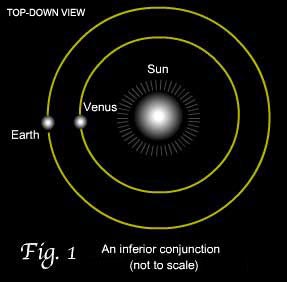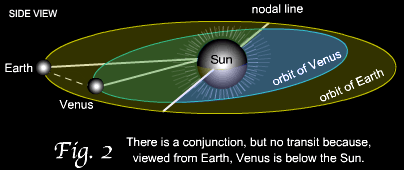What Is a Transit of Venus?
A Venus transit is a phenomenon in which the disk of the planet Venus passes like a small shadow across the face of the Sun. The transit can be seen (with proper protection!) by the unaided eye and looks something like a moving sunspot. (Sunspots take about two weeks to cross the face of the Sun, however, while Venus takes a little over six hours). Among the rarest of astronomical events, Venus transits occur eight years apart—and then don’t happen again for more than a century. The last transit before 2004 took place in 1882.
Why Do We See the Transit from Earth?
Venus is the second planet from the Sun and Earth is the third, and the planets circle the Sun at different speeds. It happens from time to time that Venus comes between Earth and the Sun, an event called an inferior conjunction.
A top-down view would look like Fig. 1.
Why
Do We See It So Rarely?
A Venus transit is similar to a solar eclipse, in which the face of the Sun is blocked by the Moon. But we don’t see a solar eclipse every time the Moon is between Earth and the Sun—which is every time there’s a new Moon. Similarly, we don’t see a transit of Venus every time Venus is between Earth and the Sun—which happens about every 584 days or 1.6 years. That’s because both Venus and the Moon, from our earthly point of view, can be above or below the Sun (Fig.2), and sunlight reaches us undisturbed.
The orbit of Venus around the Sun is tipped in relation to the orbit of Earth. As viewed from the Sun, the orbits cross at two points (called the nodes), and it is only at these points that the planets and the Sun line up directly (Fig.3).
A View of Venus' Orbit from the Moving Earth
This animation shows Venus from the perspective of the moving Earth. Here you see the position of Venus relative to Earth's orbit (the green line) in the few months leading up to June 8, 2004, and then watch as Venus transits the Sun on that date.
During the inferior conjunction of June 8, 2004, Venus is quite close to one of the nodes and is seen to transit the southern half of the Sun. Eight years later (June 5-6, 2012), during another inferior conjunction, Venus is near the same node. This time, the planet crosses the northern half of the Sun. After that, Venus won’t be near one of the nodes during a conjunction until 2117.
Why
Is the Pattern of Transits So Irregular?
Venus and Earth come into conjunction every 583.92 days. After five conjunctions (583.92 days x 5 = 2919.6 days), approximately eight years have passed (365.25 x 8 = 2922 days). If the number of days were identical, during a conjunction Venus would be in exactly the same place that it was eight years previously. However, the difference of 2.4 days means that Venus comes close to its position of eight years earlier, but it’s not in the precise spot. And that makes all the difference as far as transits are concerned. (Fig. 4)




1996
:
Venus was too far south to transit the Sun.
2004
: Venus transits the southern hemisphere
of the Sun.
2012
: Venus transits the northern hemisphere
of the Sun.
2020
: Venus will be too far north to transit the
Sun.

